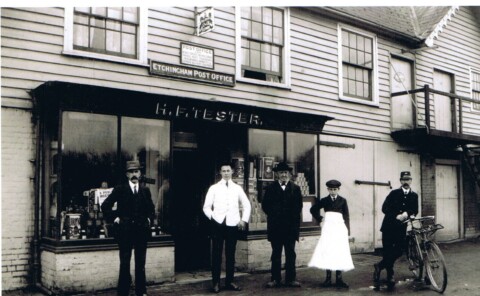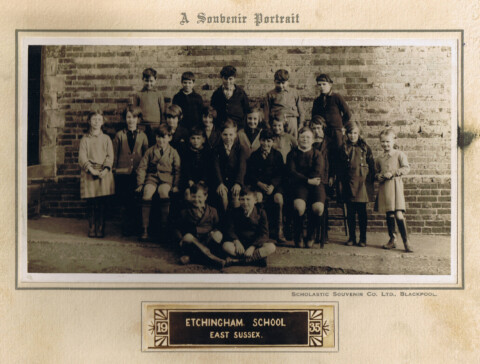ETCHINGHAM VILLAGE
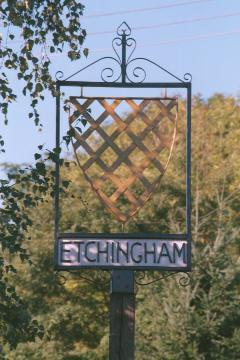
Etchingham is a small rural community, in East Sussex, England, lying in the valley at the junction of the Rivers Dudwell, Limden and Rother, which flow on through Sussex, eventually reaching the sea at Rye. The village is situated on the A265 road, which runs from the A21 to Lewes, a mile or so west of Hurst Green, which lies on the A21. The village has developed over several centuries from an Anglo Saxon settlement.The name Etchingham is probably derived from Old English, and roughly translates as “The homestead or enclosure of family and followers of a man called Ecci“. ‘inga’ in a place name usually refers to ‘people of’ or ‘dwellers at’, and ‘ham’ refers to a homestead or settlement, so this explanation seems the most probable. There is a second less likely derivation of the name, it could come from the Anglo Saxon ‘ECEN’, meaning great + ‘HAM’ (homestead), but the former explanation is the most likely.
Etchingham was a manor a long time before the Norman conquest of 1066, after this time the manor was taken over by the Normans, in 1166 it was left to the De Achyngham (Etchingham) family, who were well known landowners of the time. The Etchingham family papers record that William was so pleased with his right-hand man that he gave him the land now known as Etchingham. The moated manor house, long since demolished, stood at the point now occupied by the London to Hastings railway line, some of the stone from the manor was probably used in the construction of the station buildings.” Etchingham is a small rural community, in East Sussex, England, lying in the valley at the junction of the Rivers Dudwell, Limden and Rother, which flow on through Sussex, eventually reaching the sea at Rye. The village is situated on the A265 road, which runs from the A21 to Lewes, a mile or so west of Hurst Green, which lies on the A21.
The village has developed over several centuries from an Anglo Saxon settlement.The name Etchingham is probably derived from Old English, and roughly translates as “The homestead or enclosure of family and followers of a man called Ecci”. ‘inga’ in a place name usually refers to ‘people of’ or ‘dwellers at’, and ‘ham’ refers to a homestead or settlement, so this explanation seems the most probable. There is a second less likely derivation of the name, it could come from the Anglo Saxon ‘ECEN’, meaning great + ‘HAM’ (homestead), but the former explanation is the most likely.
Etchingham was a manor a long time before the Norman conquest of 1066, after this time the manor was taken over by the Normans, in 1166 it was left to the De Achyngham (Etchingham) family, who were well known landowners of the time. The Etchingham family papers record that William was so pleased with his right-hand man that he gave him the land now known as Etchingham. The moated manor house, long since demolished, stood at the point now occupied by the London to Hastings railway line, some of the stone from the manor was probably used in the construction of the station buildings.
The Church
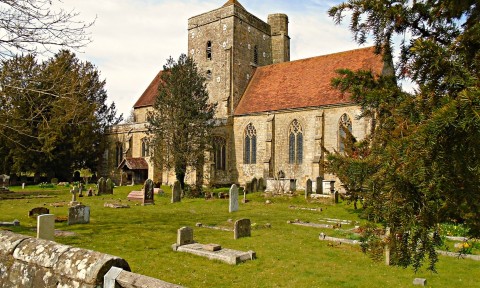
The Parish Church, The Assumption of Blessed Mary and St. Nicholas, is situated at the eastern end of the village alongside the A265. The 14th century church, built between 1362 and 1375, was originally built within grounds of the manor, both surrounded by a moat, the manor no longer exists, but evidence of the moat can still be seen.
The village War Memorial, with the names of those who gave their lives in both World Wars is located in the church path in front of ths south door.
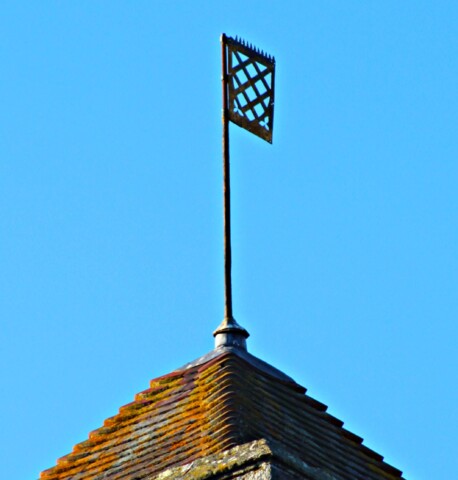
The church has a number of natable features, including probably the oldest brass weathervane in England, still in its original position, the weathervane depicts the coat of arms of the De Etchingham family, the design has been modified and used in various locations in the village including the village sign, the Parish Council logo and the Primary School badge.

The church is noted for its misericords, dating from1375, probably the largest series of misericords in Sussex, with the exception of those in Chichester Cathedral.
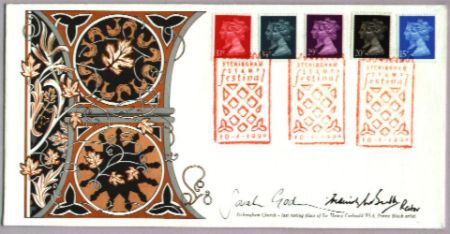
One notable feature of the village history is of interest to philatelists (stamp collectors) around the world. Henry Corbould FSA, whose drawings of Queen Victoria were used to create the world’s first postage stamp, The penny Black. Henry Corbould was travelling back to London from the coast, along what is now the A21, he was taken ill near Hurst Green and was given shelter at a local hostelry. Henry never recovered from his illness and died in his room at the Public House, and was buried in Etchingham Church, there is a memorial tablet in the church, on the wall by the side of the south door. In 1990, as part of the 150th Anniversary of the Penny Black, the PCC produced some First Day Covers for the set of stamps issued at bthe time. The covers were limited editions, designed by Sarah Godwin, a village resident at the time, Sarah had previously designed the set of Isaac Newton stamps issued in 1987, a special handstamp was designed for the covers based on the church weathervane.
The village shop which for most of its life was known as “The Etchingham Stores” was built around 1860 when the railway arrived in the village. The shop was always a grocers and general store, in the early days it was also the Post Office, and for a while it also served as the Telephone Exchange. In October 2000 the village suffered from serious flooding which forced the shop to close, the owner at the time decided not to re-open. In 2003, after a lot of work and negotiation it opened again as a Community Shop staffed by volunteers, the Community Shop closed in 2011 and the Parish Council purchased the premises for the village and a local Community Interest Company leased it and it opened again for a few years a a Shop & Deli until circumstances forced it to close, the premises remains in the ownership of the Parish Council and is leased to The Wealden Cake Company. The photo below is from the early 1900’s and shows the owner, Mr tester, Jack Walters, Mr Cox (the previous owner), Harold Walters and postman Tom Roff.
